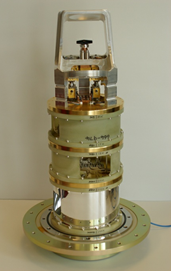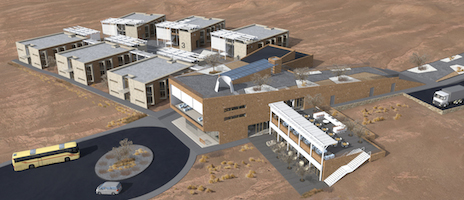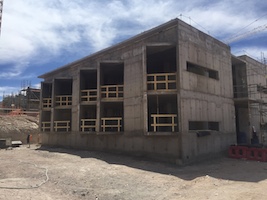ALMA Programme News
ALMA Band 5
 Within the ALMA development programme, ESO is providing an additional receiver band for ALMA: Band 5 (163 - 211 GHz). The cryogenic receiver cartridges are built by a consortium of NOVA, the research school for astronomy in the Netherlands, and Onsala Space Observatory’s Advanced Receiver Development group. NRAO builds the local oscillators that tune the receivers.
Within the ALMA development programme, ESO is providing an additional receiver band for ALMA: Band 5 (163 - 211 GHz). The cryogenic receiver cartridges are built by a consortium of NOVA, the research school for astronomy in the Netherlands, and Onsala Space Observatory’s Advanced Receiver Development group. NRAO builds the local oscillators that tune the receivers.
Band 5 full production and integration at the OSF proceeds very well - 11 receivers have already been integrated into antennas. In July the first fringes with the Band 5 production cartridges have been achieved (see ESO announcement http://www.eso.org/public/announcements/ann15059/). On 31 July, using three antennas equipped with Band 5, successful phase closure has been demonstrated on sky. Receiver production, integration and commissioning work will continue into 2017, and it is well possible that Band 5 may be offered for proposals in Cycle 5.
One of the refurbished ALMA Band 5 prototype receivers has been installed on APEX in the SEPIA instrument. SEPIA is currently running the first season of regular observations and many Science Verification projects data are available on the ESO webpages.
New ALMA modes for Cycle 4: mmVLBI, Solar and ACA standalone and Large Programmes
Following the successful ALMA Phasing Project and the coordination of the mmVLBI network providers, from Cycle 4 it will be possible to apply for the use of ALMA as a station of a VLBI network. Following the outcome of an ALMA Upgrade Study led by MPIfR in Europe, ALMA will be offered as a station of the GMVA operating in the 3mm band. Details on how to apply for ALMA as a mmVLBI station will be available on the ALMA Science Portal by mid-January. In Cycle 4 ALMA will also provide access to some of the Solar Observing modes, following extensive commissioning campaigns, also supported by an ALMA Development Study led by the Ondrejov ARC node. Interferometric and single dish observations of the Sun will be offered at selected frequencies in Bands 3 and 6. ACA standalone observations and Large Programmes will also be offered in Cycle 4. More information on these are available in the Cycle 4 pre-announcement: https://almascience.eso.org/news/alma-cycle-4-pre-announcement
Development Studies
As part of the ALMA development programme, several upgrade studies are running in Europe. These range from the development of new receiver bands, upgrade of existing hardware and software systems. mmVLBI operations and Solar Observing use cases and algorithms are two examples that allowed to deliver two new observing modes for ALMA. Others will be described in future issues of this Newsletter.
ALMA Residence

Fig. 1: Architectural concept |

Fig. 2: First dormitory buildings |
The construction of the ALMA Residence, ESO's last construction programme item to be delivered to ALMA, started in February 2015 and is progressing very well. The architectural concept (Fig. 1) defines six dormitory buildings, with 20 rooms each, and a central building with the restaurant and community and leisure facilities. By now the first dormitory buildings have been erected (Fig. 2) and the building is on track for delivery in the second half of 2016. The construction can be followed in real time via two web cams - the images are available at http://www.eso.org/public/teles-instr/alma/residencia/.
Staff News
Effective 1 July 2015, the ARC department at ESO has moved from the DMO to the EASC division in order to consolidate the ESO-ALMA off-site operations. This move was a purely ESO internal re-organization.
John Carpenter has taken up the position of Observatory Scientist at the JAO in September.
Upcoming ALMA or ALMA-related Meetings
Resolving Planet Formation in the Era of ALMA and Extreme AO
Joint ESO, ALMA, NAOJ, NRAO Workshop: ESO Vitacura, Santiago, Chile, 16–20 May 2016
Results from ALMA Long Baseline observations and from SPHERE, Gemini Planet Imager (GPI) and other high-contrast adaptive optics (AO) instruments have given a taste of what to expect over the next few years in the fields of protoplanetary and debris disks, and planet formation. For the first time observations of the regions where planets form are achievable. The workshop will discuss the state-of-the-art results, offering a panchromatic view, with a balance between observations and theory. Discussions will be scheduled on how facilities, such as JWST, E-ELT and TMT, and advances in modeling, will advance the field of planetary formation.
Details are available from the workshop webpage and further information may be obtained by email.
Workshops at the Nordic ARC Node to prepare for the Call for Proposals for ALMA Cycle 4
In connection with the call for proposals for ALMA Cycle 4 the Nordic ARC node will be arranging workshops to provide direct, hands-on help with proposal preparation. In addition to general ALMA workshops, we will this time arrange science oriented workshops to give more focus on the scientific areas of interest to the Nordic region. All meetings are open to all ALMA users, although preference will be given to participants from the Nordic regions.
More detailed information on the workshops is available in the EU ARC Announcement and will appear on our homepage www.nordic-alma.se in early 2016.